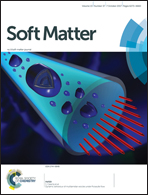A 2.5D approach to the mechanics of electrospun fibre mats
Abstract
In this paper, a discrete random network modelling approach specific to electrospun networks is presented. Owing to the manufacturing process, fibres in these materials systems have an enormous length, as compared to their diameters, and form sparse networks since fibre contact over thickness is limited to a narrow range. Representative volume elements are generated, in which fibres span the entire domain, and a technique is developed to apply computationally favourable periodic boundary conditions despite the initial non-periodicity of the networks. To capture sparsity, a physically motivated method is proposed to distinguish true fibre cross-links, in which mechanical interaction takes place, from mere fibre intersections. The model is exclusively informed by experimentally accessible parameters, demonstrates excellent agreement with the mechanical response of electrospun fibre mats, captures typical microscopic deformation patterns, and provides information on the kinematics of fibres and pores. This ability to address relevant mechanisms of deformation at both micro- and macroscopic length scales, together with the moderate computational cost, render the proposed modelling approach a highly qualified tool for the computer-based design and optimization of electrospun networks.



 Please wait while we load your content...
Please wait while we load your content...